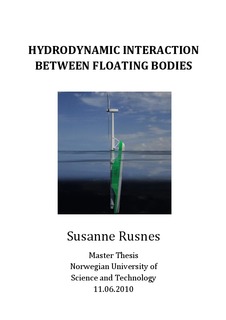| dc.description.abstract | This thesis is written in collaboration with WindFlip AS in order to investigate the behavior of Hywind and WindFlip after the release of Hywind from the WindFlip vessel. Potential theory has been applied, and no viscosity has been taken into account in any part of the analysis.
The interaction between two floating bodies in waves has been the major topic in this thesis. A literature study has been performed on the effects of interaction in steady flow and waves. The findings from the study indicate an increase in motions for the structure placed against the weather, and a reduction in motions for the lee-side structure. This results in a suggested configuration for the release operation, where WindFlip is placed up against the waves and Hywind in the sheltered area behind WindFlip.
The motions of a basic single circular cylinder in regular waves are also looked into. By performing simplified analyses in Matlab and Wadam, the fundamental behavior of buoy-like structures such as Hywind and WindFlip was looked into in order to obtain an understanding of how the structures respond to incident waves.
The WindFlip barge is to transport the wind turbine lying horizontally on top of WindFlip. Ballasting the barge at location will cause the structures to rotate to vertical position. The flipping procedure is estimated to last about six hours, and within this timeframe the structures will go through many different positions which again will lead to different responses to the waves. Three different positions have been looked into for the coupled WindFlip/Hywind structure, and the results are compared to results from model testing of these configurations. The numerical results compare well to the model test, which implies that the numerical analyses can be trusted and used for further evaluation of the process.
Two identical circular cylinders freely floating in waves are looked into by a multibody analysis in the potential theory solver Wadam. The effects of the multibody analyses show the same trends as the literature study – an increase in motions for the weather side cylinder, and a decrease for the lee-side cylinder. The interaction effects do not give large alterations in the motions compared to single body analyses. The reason for this may be the viscous effects in the interaction, which is not accounted for in Wadam.
By introducing an offbody point grid showing the free surface around the cylinders we observe lower waves in the wake behind the weather side cylinder. This also corresponds to the sheltering effects found in the literature study, and the reduction in response for the lee side-cylinder found in the multibody analyses.
Multibody analyses have been performed for the specific case of WindFlip and Hywind by the use of Wadam. The release configuration suggested from the literature study is applied in the analyses, and regular waves between 5 and 23 seconds are used. Also in this case the responses for the weather side structure (WindFlip) are increased when the spacing between the structures is reduced, and the responses for the lee-side cylinder (Hywind) show a decrease with reduced spacing. The effects from interaction on the response amplitudes are not prominent in this case either, and the viscous effects will most probably have a greater influence on the interaction between the structures.
A Matlab script has been made to visualize the motions of the two structures including the interaction effects on the phase angles and response amplitudes. From the visualizations we are able to detect combinations of wave periods and spacing that might be critical for the operation and hence should be looked into more closely.
A second Matlab script goes through all possible wave period and spacing combinations, and shows graphically which situations that will cause the structures to collide in either the top or bottom point. The script always uses the response amplitude values for the motions, and by that we end up with an RAO for the horizontal distance between the structures. This RAO for the distance will be further applied by the WindFlip team in order to perform statistical studies on which situations are likely to give collisions between WindFlip and Hywind during the release process. | nb_NO |
